Business and Business Environment Analysis: Tesco, NHS, Oxfam
VerifiedAdded on 2020/10/23
|21
|5660
|495
Report
AI Summary
This report provides a comprehensive analysis of the business environments of three distinct organizations: Tesco, the National Health Service (NHS), and Oxfam. It begins by explaining the different types and purposes of organizations, including private, public, and voluntary sectors, along with their respective legal structures. The report then delves into the size and scope of these organizations, examining their missions, visions, objectives, and stakeholders. Furthermore, it explores the interrelationship between organizational functions and objectives, highlighting the advantages and disadvantages of these relationships. The macro environment's impact on business operations is assessed using the PESTLE model, followed by an internal and external analysis employing the SWOT framework. The analysis critically evaluates how both macro and micro factors influence business objectives and decision-making processes, offering a detailed understanding of the complexities within each organization. The report concludes by synthesizing the findings, providing a holistic view of the business environments of Tesco, NHS, and Oxfam.
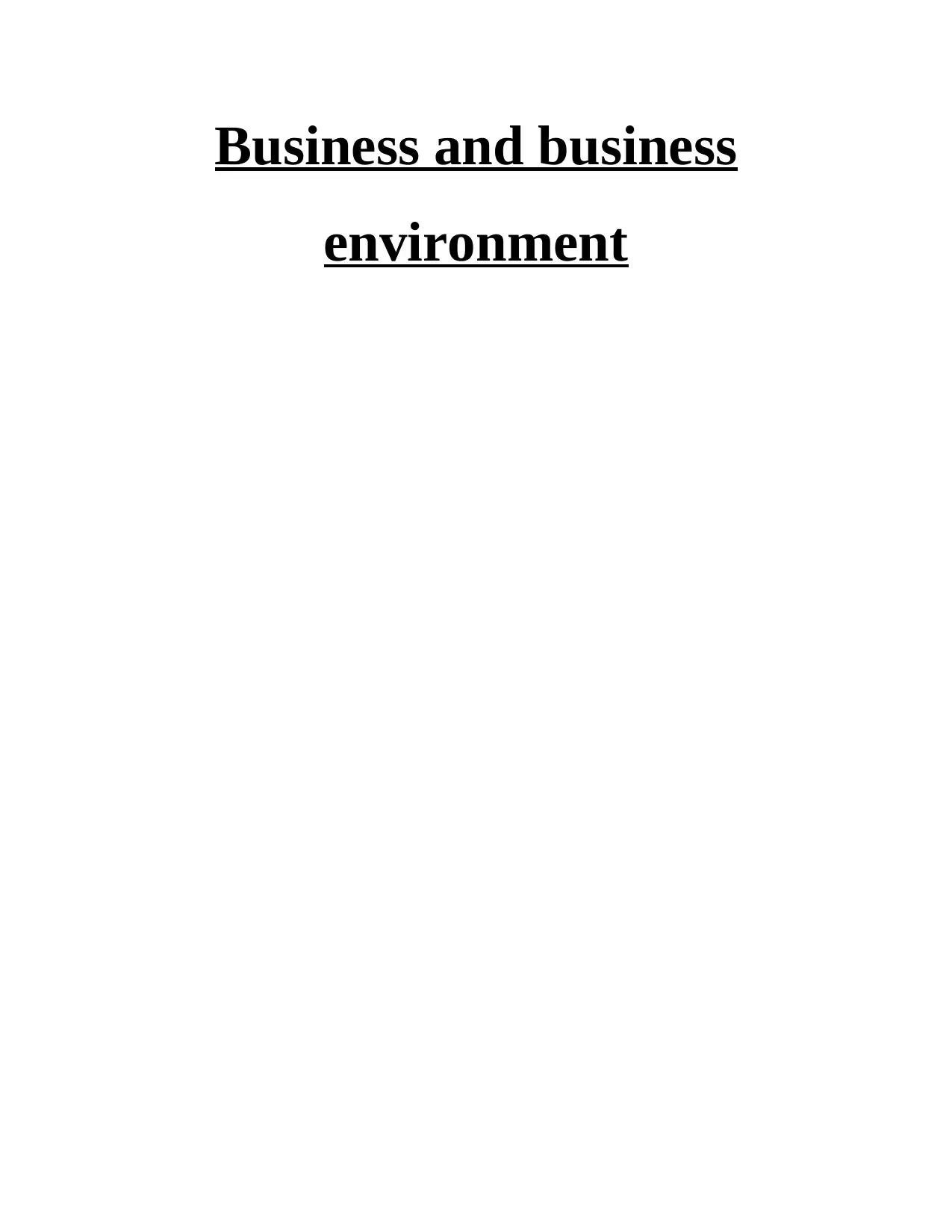
Business and business
environment
environment
Paraphrase This Document
Need a fresh take? Get an instant paraphrase of this document with our AI Paraphraser
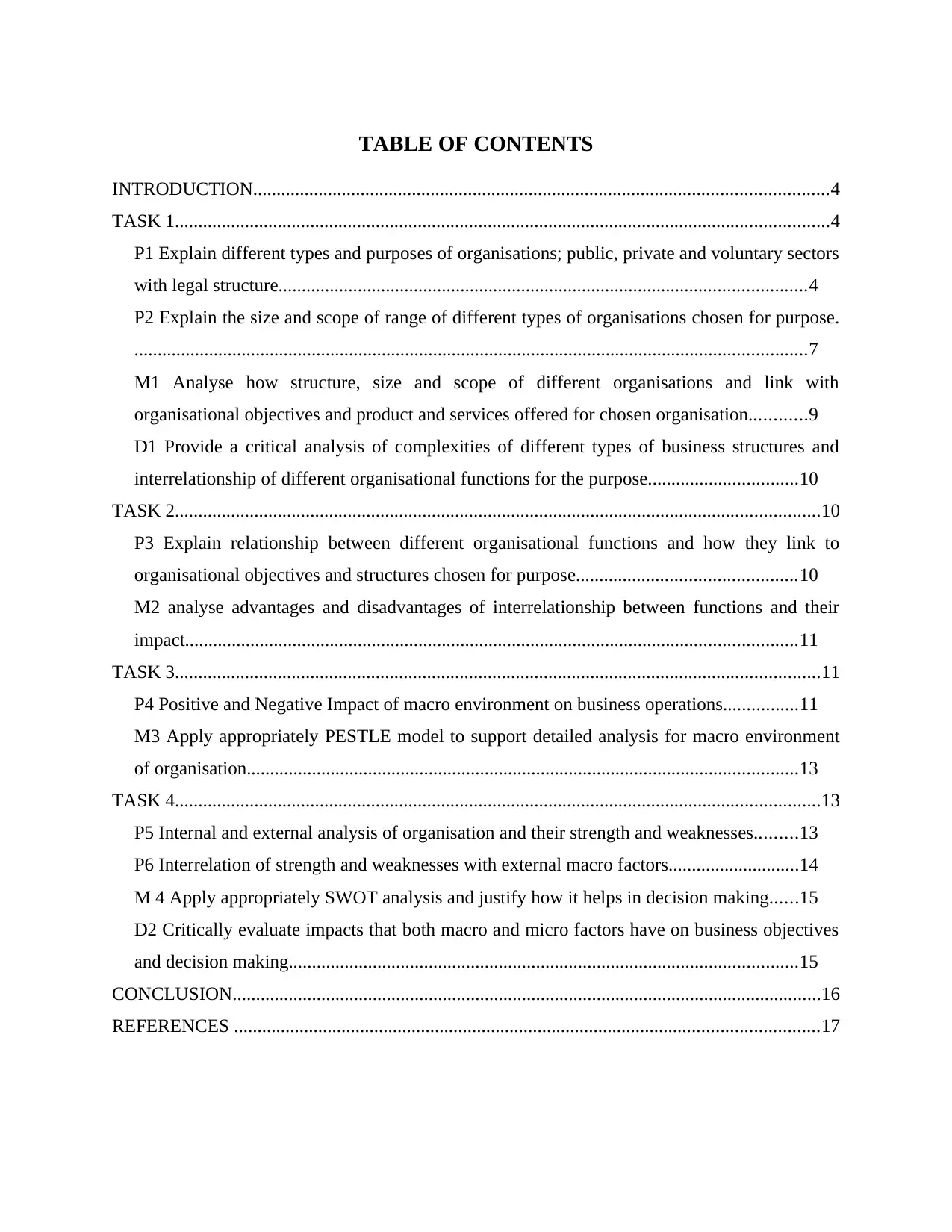
TABLE OF CONTENTS
INTRODUCTION...........................................................................................................................4
TASK 1............................................................................................................................................4
P1 Explain different types and purposes of organisations; public, private and voluntary sectors
with legal structure.................................................................................................................4
P2 Explain the size and scope of range of different types of organisations chosen for purpose.
................................................................................................................................................7
M1 Analyse how structure, size and scope of different organisations and link with
organisational objectives and product and services offered for chosen organisation............9
D1 Provide a critical analysis of complexities of different types of business structures and
interrelationship of different organisational functions for the purpose................................10
TASK 2..........................................................................................................................................10
P3 Explain relationship between different organisational functions and how they link to
organisational objectives and structures chosen for purpose...............................................10
M2 analyse advantages and disadvantages of interrelationship between functions and their
impact...................................................................................................................................11
TASK 3..........................................................................................................................................11
P4 Positive and Negative Impact of macro environment on business operations................11
M3 Apply appropriately PESTLE model to support detailed analysis for macro environment
of organisation......................................................................................................................13
TASK 4..........................................................................................................................................13
P5 Internal and external analysis of organisation and their strength and weaknesses.........13
P6 Interrelation of strength and weaknesses with external macro factors............................14
M 4 Apply appropriately SWOT analysis and justify how it helps in decision making......15
D2 Critically evaluate impacts that both macro and micro factors have on business objectives
and decision making.............................................................................................................15
CONCLUSION..............................................................................................................................16
REFERENCES .............................................................................................................................17
INTRODUCTION...........................................................................................................................4
TASK 1............................................................................................................................................4
P1 Explain different types and purposes of organisations; public, private and voluntary sectors
with legal structure.................................................................................................................4
P2 Explain the size and scope of range of different types of organisations chosen for purpose.
................................................................................................................................................7
M1 Analyse how structure, size and scope of different organisations and link with
organisational objectives and product and services offered for chosen organisation............9
D1 Provide a critical analysis of complexities of different types of business structures and
interrelationship of different organisational functions for the purpose................................10
TASK 2..........................................................................................................................................10
P3 Explain relationship between different organisational functions and how they link to
organisational objectives and structures chosen for purpose...............................................10
M2 analyse advantages and disadvantages of interrelationship between functions and their
impact...................................................................................................................................11
TASK 3..........................................................................................................................................11
P4 Positive and Negative Impact of macro environment on business operations................11
M3 Apply appropriately PESTLE model to support detailed analysis for macro environment
of organisation......................................................................................................................13
TASK 4..........................................................................................................................................13
P5 Internal and external analysis of organisation and their strength and weaknesses.........13
P6 Interrelation of strength and weaknesses with external macro factors............................14
M 4 Apply appropriately SWOT analysis and justify how it helps in decision making......15
D2 Critically evaluate impacts that both macro and micro factors have on business objectives
and decision making.............................................................................................................15
CONCLUSION..............................................................................................................................16
REFERENCES .............................................................................................................................17

INTRODUCTION
Business environment is sum total of internal and external factors that influence business
proceedings. Business environment consist of threats for firm and immense opportunities that
offers exploitation of marketplace an. Business environment consist of individuals, entities and
many other factors which are not under control of organisation but it affects business
performance, profitability and growth for survive for long time. This report is based on Tesco
which is a British multinational private owner company that deals in groceries and general
merchandise retailer. It is headquartered in England, UK and third largest retailer in world wide.
Apart from this, report will outline public and voluntary organisation also consist by types, size
and scope of that organisation. In it also consist different functions that perform in organisation
and their relationship with other departments. Further it emphasises on effect of macro
environment on operations of business with both internal and external factors and their
interrelation with one another.
TASK 1
P1 Explain different types and purposes of organisations; public, private and voluntary sectors
with legal structure.
There are many types of organisation that helps individual as well as organisation growth
and enhancement. In that scenario mainly three types of organisations are discussed in which
private, public and voluntary organisation.
Private organisation:
Private sector is part of whole economy which run by individual and organisation for
profit making purpose. In it includes all organisation which operates for profit making purpose
that are not owner and operated by government (Hilton and Platt, 2013). In that report private
sector organisation is Tesco which is third largest retailer at worldwide. Tesco is multinational
groceries and merchandise retailer in world wide.
Purpose
In purpose of Tesco is to serve shoppers better than every day. Their main purpose is to
champion for customers and enables to give better experiences to their customers and give easier
way to live life (Bharadwaj and et. al., 2013.).
Types of private sector:
Business environment is sum total of internal and external factors that influence business
proceedings. Business environment consist of threats for firm and immense opportunities that
offers exploitation of marketplace an. Business environment consist of individuals, entities and
many other factors which are not under control of organisation but it affects business
performance, profitability and growth for survive for long time. This report is based on Tesco
which is a British multinational private owner company that deals in groceries and general
merchandise retailer. It is headquartered in England, UK and third largest retailer in world wide.
Apart from this, report will outline public and voluntary organisation also consist by types, size
and scope of that organisation. In it also consist different functions that perform in organisation
and their relationship with other departments. Further it emphasises on effect of macro
environment on operations of business with both internal and external factors and their
interrelation with one another.
TASK 1
P1 Explain different types and purposes of organisations; public, private and voluntary sectors
with legal structure.
There are many types of organisation that helps individual as well as organisation growth
and enhancement. In that scenario mainly three types of organisations are discussed in which
private, public and voluntary organisation.
Private organisation:
Private sector is part of whole economy which run by individual and organisation for
profit making purpose. In it includes all organisation which operates for profit making purpose
that are not owner and operated by government (Hilton and Platt, 2013). In that report private
sector organisation is Tesco which is third largest retailer at worldwide. Tesco is multinational
groceries and merchandise retailer in world wide.
Purpose
In purpose of Tesco is to serve shoppers better than every day. Their main purpose is to
champion for customers and enables to give better experiences to their customers and give easier
way to live life (Bharadwaj and et. al., 2013.).
Types of private sector:
⊘ This is a preview!⊘
Do you want full access?
Subscribe today to unlock all pages.

Trusted by 1+ million students worldwide
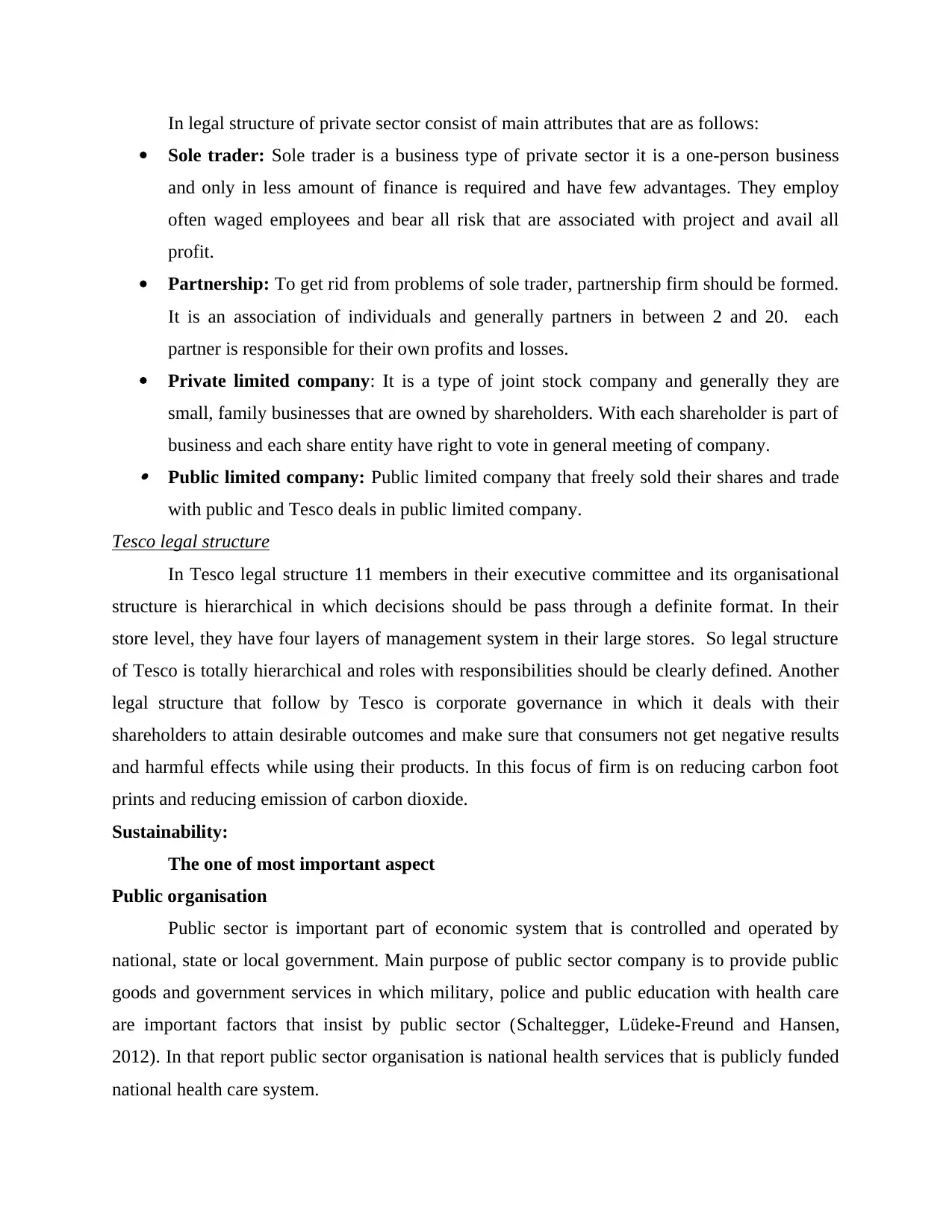
In legal structure of private sector consist of main attributes that are as follows:
Sole trader: Sole trader is a business type of private sector it is a one-person business
and only in less amount of finance is required and have few advantages. They employ
often waged employees and bear all risk that are associated with project and avail all
profit.
Partnership: To get rid from problems of sole trader, partnership firm should be formed.
It is an association of individuals and generally partners in between 2 and 20. each
partner is responsible for their own profits and losses.
Private limited company: It is a type of joint stock company and generally they are
small, family businesses that are owned by shareholders. With each shareholder is part of
business and each share entity have right to vote in general meeting of company. Public limited company: Public limited company that freely sold their shares and trade
with public and Tesco deals in public limited company.
Tesco legal structure
In Tesco legal structure 11 members in their executive committee and its organisational
structure is hierarchical in which decisions should be pass through a definite format. In their
store level, they have four layers of management system in their large stores. So legal structure
of Tesco is totally hierarchical and roles with responsibilities should be clearly defined. Another
legal structure that follow by Tesco is corporate governance in which it deals with their
shareholders to attain desirable outcomes and make sure that consumers not get negative results
and harmful effects while using their products. In this focus of firm is on reducing carbon foot
prints and reducing emission of carbon dioxide.
Sustainability:
The one of most important aspect
Public organisation
Public sector is important part of economic system that is controlled and operated by
national, state or local government. Main purpose of public sector company is to provide public
goods and government services in which military, police and public education with health care
are important factors that insist by public sector (Schaltegger, Lüdeke-Freund and Hansen,
2012). In that report public sector organisation is national health services that is publicly funded
national health care system.
Sole trader: Sole trader is a business type of private sector it is a one-person business
and only in less amount of finance is required and have few advantages. They employ
often waged employees and bear all risk that are associated with project and avail all
profit.
Partnership: To get rid from problems of sole trader, partnership firm should be formed.
It is an association of individuals and generally partners in between 2 and 20. each
partner is responsible for their own profits and losses.
Private limited company: It is a type of joint stock company and generally they are
small, family businesses that are owned by shareholders. With each shareholder is part of
business and each share entity have right to vote in general meeting of company. Public limited company: Public limited company that freely sold their shares and trade
with public and Tesco deals in public limited company.
Tesco legal structure
In Tesco legal structure 11 members in their executive committee and its organisational
structure is hierarchical in which decisions should be pass through a definite format. In their
store level, they have four layers of management system in their large stores. So legal structure
of Tesco is totally hierarchical and roles with responsibilities should be clearly defined. Another
legal structure that follow by Tesco is corporate governance in which it deals with their
shareholders to attain desirable outcomes and make sure that consumers not get negative results
and harmful effects while using their products. In this focus of firm is on reducing carbon foot
prints and reducing emission of carbon dioxide.
Sustainability:
The one of most important aspect
Public organisation
Public sector is important part of economic system that is controlled and operated by
national, state or local government. Main purpose of public sector company is to provide public
goods and government services in which military, police and public education with health care
are important factors that insist by public sector (Schaltegger, Lüdeke-Freund and Hansen,
2012). In that report public sector organisation is national health services that is publicly funded
national health care system.
Paraphrase This Document
Need a fresh take? Get an instant paraphrase of this document with our AI Paraphraser
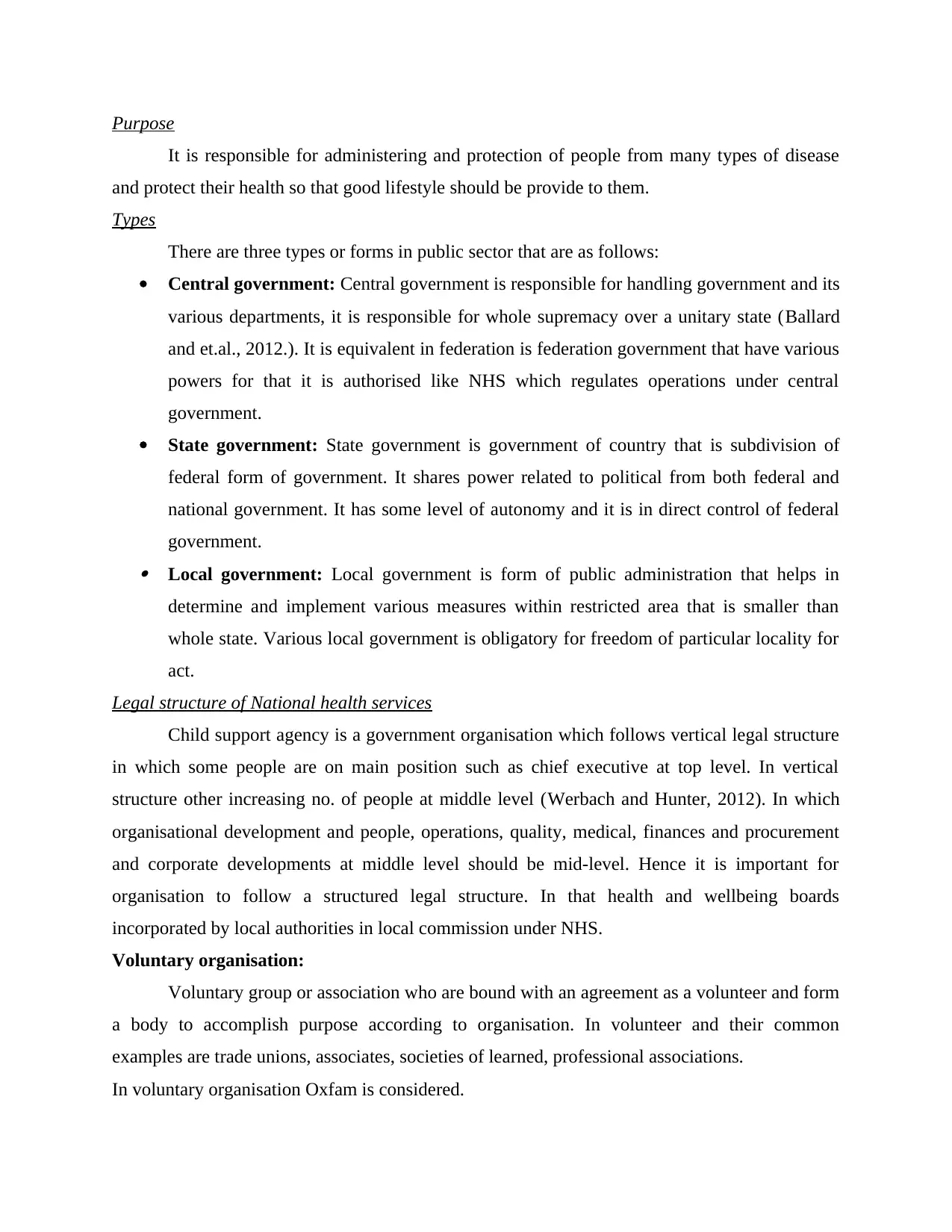
Purpose
It is responsible for administering and protection of people from many types of disease
and protect their health so that good lifestyle should be provide to them.
Types
There are three types or forms in public sector that are as follows:
Central government: Central government is responsible for handling government and its
various departments, it is responsible for whole supremacy over a unitary state (Ballard
and et.al., 2012.). It is equivalent in federation is federation government that have various
powers for that it is authorised like NHS which regulates operations under central
government.
State government: State government is government of country that is subdivision of
federal form of government. It shares power related to political from both federal and
national government. It has some level of autonomy and it is in direct control of federal
government. Local government: Local government is form of public administration that helps in
determine and implement various measures within restricted area that is smaller than
whole state. Various local government is obligatory for freedom of particular locality for
act.
Legal structure of National health services
Child support agency is a government organisation which follows vertical legal structure
in which some people are on main position such as chief executive at top level. In vertical
structure other increasing no. of people at middle level (Werbach and Hunter, 2012). In which
organisational development and people, operations, quality, medical, finances and procurement
and corporate developments at middle level should be mid-level. Hence it is important for
organisation to follow a structured legal structure. In that health and wellbeing boards
incorporated by local authorities in local commission under NHS.
Voluntary organisation:
Voluntary group or association who are bound with an agreement as a volunteer and form
a body to accomplish purpose according to organisation. In volunteer and their common
examples are trade unions, associates, societies of learned, professional associations.
In voluntary organisation Oxfam is considered.
It is responsible for administering and protection of people from many types of disease
and protect their health so that good lifestyle should be provide to them.
Types
There are three types or forms in public sector that are as follows:
Central government: Central government is responsible for handling government and its
various departments, it is responsible for whole supremacy over a unitary state (Ballard
and et.al., 2012.). It is equivalent in federation is federation government that have various
powers for that it is authorised like NHS which regulates operations under central
government.
State government: State government is government of country that is subdivision of
federal form of government. It shares power related to political from both federal and
national government. It has some level of autonomy and it is in direct control of federal
government. Local government: Local government is form of public administration that helps in
determine and implement various measures within restricted area that is smaller than
whole state. Various local government is obligatory for freedom of particular locality for
act.
Legal structure of National health services
Child support agency is a government organisation which follows vertical legal structure
in which some people are on main position such as chief executive at top level. In vertical
structure other increasing no. of people at middle level (Werbach and Hunter, 2012). In which
organisational development and people, operations, quality, medical, finances and procurement
and corporate developments at middle level should be mid-level. Hence it is important for
organisation to follow a structured legal structure. In that health and wellbeing boards
incorporated by local authorities in local commission under NHS.
Voluntary organisation:
Voluntary group or association who are bound with an agreement as a volunteer and form
a body to accomplish purpose according to organisation. In volunteer and their common
examples are trade unions, associates, societies of learned, professional associations.
In voluntary organisation Oxfam is considered.
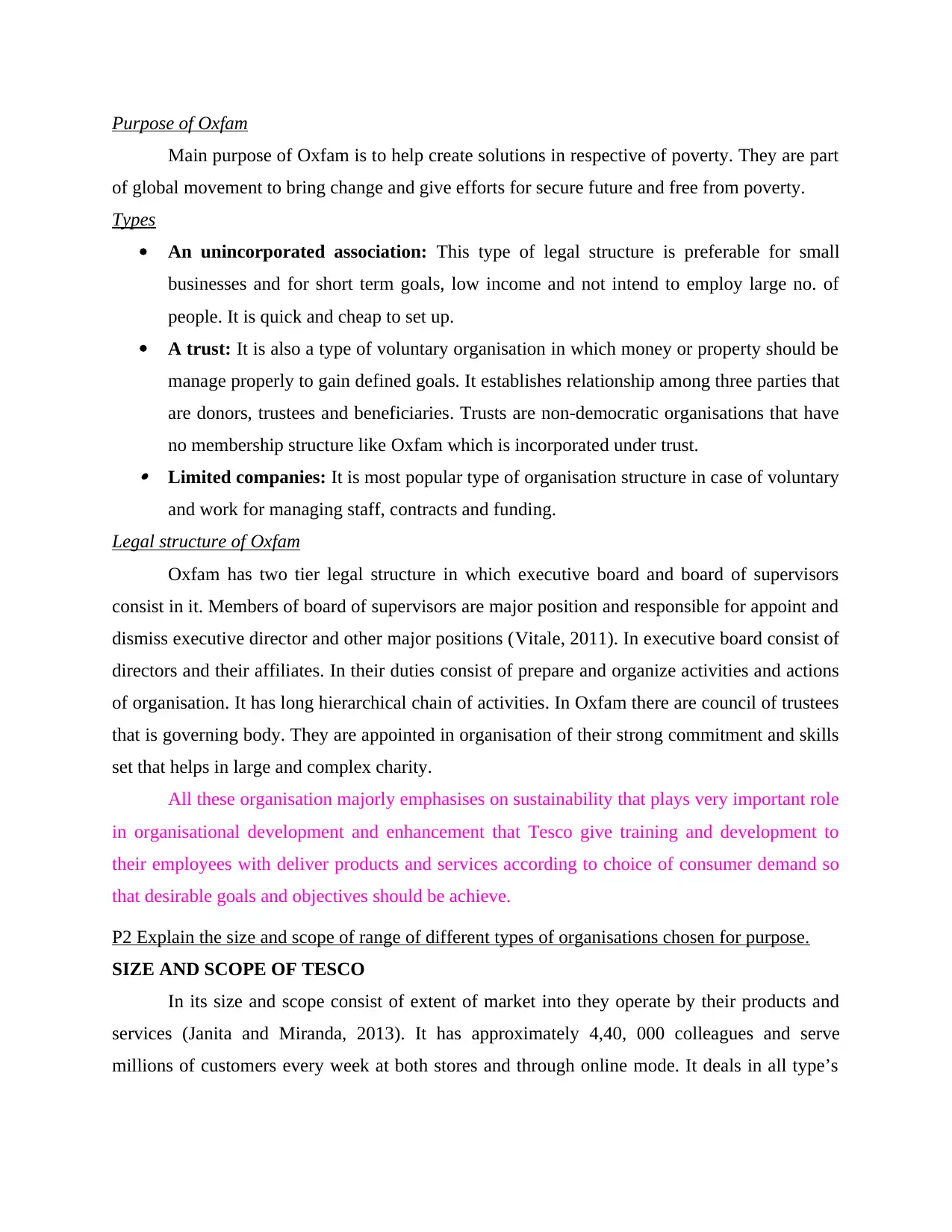
Purpose of Oxfam
Main purpose of Oxfam is to help create solutions in respective of poverty. They are part
of global movement to bring change and give efforts for secure future and free from poverty.
Types
An unincorporated association: This type of legal structure is preferable for small
businesses and for short term goals, low income and not intend to employ large no. of
people. It is quick and cheap to set up.
A trust: It is also a type of voluntary organisation in which money or property should be
manage properly to gain defined goals. It establishes relationship among three parties that
are donors, trustees and beneficiaries. Trusts are non-democratic organisations that have
no membership structure like Oxfam which is incorporated under trust. Limited companies: It is most popular type of organisation structure in case of voluntary
and work for managing staff, contracts and funding.
Legal structure of Oxfam
Oxfam has two tier legal structure in which executive board and board of supervisors
consist in it. Members of board of supervisors are major position and responsible for appoint and
dismiss executive director and other major positions (Vitale, 2011). In executive board consist of
directors and their affiliates. In their duties consist of prepare and organize activities and actions
of organisation. It has long hierarchical chain of activities. In Oxfam there are council of trustees
that is governing body. They are appointed in organisation of their strong commitment and skills
set that helps in large and complex charity.
All these organisation majorly emphasises on sustainability that plays very important role
in organisational development and enhancement that Tesco give training and development to
their employees with deliver products and services according to choice of consumer demand so
that desirable goals and objectives should be achieve.
P2 Explain the size and scope of range of different types of organisations chosen for purpose.
SIZE AND SCOPE OF TESCO
In its size and scope consist of extent of market into they operate by their products and
services (Janita and Miranda, 2013). It has approximately 4,40, 000 colleagues and serve
millions of customers every week at both stores and through online mode. It deals in all type’s
Main purpose of Oxfam is to help create solutions in respective of poverty. They are part
of global movement to bring change and give efforts for secure future and free from poverty.
Types
An unincorporated association: This type of legal structure is preferable for small
businesses and for short term goals, low income and not intend to employ large no. of
people. It is quick and cheap to set up.
A trust: It is also a type of voluntary organisation in which money or property should be
manage properly to gain defined goals. It establishes relationship among three parties that
are donors, trustees and beneficiaries. Trusts are non-democratic organisations that have
no membership structure like Oxfam which is incorporated under trust. Limited companies: It is most popular type of organisation structure in case of voluntary
and work for managing staff, contracts and funding.
Legal structure of Oxfam
Oxfam has two tier legal structure in which executive board and board of supervisors
consist in it. Members of board of supervisors are major position and responsible for appoint and
dismiss executive director and other major positions (Vitale, 2011). In executive board consist of
directors and their affiliates. In their duties consist of prepare and organize activities and actions
of organisation. It has long hierarchical chain of activities. In Oxfam there are council of trustees
that is governing body. They are appointed in organisation of their strong commitment and skills
set that helps in large and complex charity.
All these organisation majorly emphasises on sustainability that plays very important role
in organisational development and enhancement that Tesco give training and development to
their employees with deliver products and services according to choice of consumer demand so
that desirable goals and objectives should be achieve.
P2 Explain the size and scope of range of different types of organisations chosen for purpose.
SIZE AND SCOPE OF TESCO
In its size and scope consist of extent of market into they operate by their products and
services (Janita and Miranda, 2013). It has approximately 4,40, 000 colleagues and serve
millions of customers every week at both stores and through online mode. It deals in all type’s
⊘ This is a preview!⊘
Do you want full access?
Subscribe today to unlock all pages.

Trusted by 1+ million students worldwide

products sell from their platform. It deals in different products in which cleaners, TV and many
other. It has 6800 outlets around the world and its market share 28.3% at worldwide.
Vision and mission
Their mission statement is “We make what matters better, together”. With vision are
interrelate and shape the whole organisation.
Objectives
There main objective is to provide groceries, electronics and clothing products and no. of
other services to their target customers. They also aiming to target their consumer base through
online to grab large no. of consumers.
Stakeholders
A stakeholder is an individual, company or an institution that owns or hold share of stock
of organisation. Main stakeholders of Tesco are as follows:
Customers: Customer is an individual that purchase goods and services of particular
company in case of Tesco its customers want that they product high quality products that
are worth for their money.
Employees: Employee one who give their best efforts in achieving organisational goals
and objectives. In case of Tesco it focusses on giving all facilitate and security to their
employees so that they can enhance their morale and can give their best.
Suppliers: Supplier is one who supply products and services to customer, they also
known as vendor. In case of Tesco their suppliers are highly credible and provide quick
and accurate products to their potential consumers.
NATIONAL HEALTH SERVICES
National health services are a public company which operates system of healthcare in
each continent of UK.
Size and scope of NHS
NHS employs exceeds from 1.5 million people and one of highest workforce, it caters
approximately 54.3 million people and 1.2 million people employ. In its staff members 3,14,996
nurses and 150273 doctors give their services.
In its scope consist of enhancement in health professionals by providing various types of
knowledge and information to them (Wheelen and et. al., 2017). It also focusses on giving more
efficient roles and responsibilities according to their specialized skill set.
other. It has 6800 outlets around the world and its market share 28.3% at worldwide.
Vision and mission
Their mission statement is “We make what matters better, together”. With vision are
interrelate and shape the whole organisation.
Objectives
There main objective is to provide groceries, electronics and clothing products and no. of
other services to their target customers. They also aiming to target their consumer base through
online to grab large no. of consumers.
Stakeholders
A stakeholder is an individual, company or an institution that owns or hold share of stock
of organisation. Main stakeholders of Tesco are as follows:
Customers: Customer is an individual that purchase goods and services of particular
company in case of Tesco its customers want that they product high quality products that
are worth for their money.
Employees: Employee one who give their best efforts in achieving organisational goals
and objectives. In case of Tesco it focusses on giving all facilitate and security to their
employees so that they can enhance their morale and can give their best.
Suppliers: Supplier is one who supply products and services to customer, they also
known as vendor. In case of Tesco their suppliers are highly credible and provide quick
and accurate products to their potential consumers.
NATIONAL HEALTH SERVICES
National health services are a public company which operates system of healthcare in
each continent of UK.
Size and scope of NHS
NHS employs exceeds from 1.5 million people and one of highest workforce, it caters
approximately 54.3 million people and 1.2 million people employ. In its staff members 3,14,996
nurses and 150273 doctors give their services.
In its scope consist of enhancement in health professionals by providing various types of
knowledge and information to them (Wheelen and et. al., 2017). It also focusses on giving more
efficient roles and responsibilities according to their specialized skill set.
Paraphrase This Document
Need a fresh take? Get an instant paraphrase of this document with our AI Paraphraser

Vision and mission
Vision of National health services is to deliver better care, value and heath services
whereas mission is to provide quality health care services every day to all
Stakeholders
in stakeholders of NHS consist of customer which come to solve their problems or
diseases that are major stakeholder. On other hand employees as mention above doctors, nurses
that give their services in gaining their goals and objectives (Cybercrime, 2011). With suppliers
are persons who supply tools and equipment’s when hospitals required to better solution of their
problems. Hence all contributes in organisational development and their enhancement.
OXFAM
Oxfam is a group of 20 independent charitable organisations that focus on eradication of
poverty. It is a major non-profit organisation with extensive of operations.
Size and scope of Oxfam
Oxfam is an international confederation with 19 organisations that work under it and
local communities that work in almost 90 countries. It works in eradication of poverty because
one person in three are under poverty line.
Vision and mission
their vision is to create world without poverty and build atmosphere in which people can
take decisions that directly affect their lives, enjoy rights and accomplish their responsibilities
and world in which everyone should be treated equally.
Objectives
In their objectives consists of eradicate poverty and create world where women and men
should be treated in equitable manner and they can take decisions own that affect their lives.
Stakeholders
In their stakeholders consist of donors that are responsible for donations in meeting their
targets. They donate materials that are distributed in time of need at any circumstances (Weiss,
2014). On other hand in their stakeholders includes suppliers which supply products and services
and expect that company would give them money and other benefits on time. Other stakeholders
consist of partners which work outside an organisation and work together to make profit.
Vision of National health services is to deliver better care, value and heath services
whereas mission is to provide quality health care services every day to all
Stakeholders
in stakeholders of NHS consist of customer which come to solve their problems or
diseases that are major stakeholder. On other hand employees as mention above doctors, nurses
that give their services in gaining their goals and objectives (Cybercrime, 2011). With suppliers
are persons who supply tools and equipment’s when hospitals required to better solution of their
problems. Hence all contributes in organisational development and their enhancement.
OXFAM
Oxfam is a group of 20 independent charitable organisations that focus on eradication of
poverty. It is a major non-profit organisation with extensive of operations.
Size and scope of Oxfam
Oxfam is an international confederation with 19 organisations that work under it and
local communities that work in almost 90 countries. It works in eradication of poverty because
one person in three are under poverty line.
Vision and mission
their vision is to create world without poverty and build atmosphere in which people can
take decisions that directly affect their lives, enjoy rights and accomplish their responsibilities
and world in which everyone should be treated equally.
Objectives
In their objectives consists of eradicate poverty and create world where women and men
should be treated in equitable manner and they can take decisions own that affect their lives.
Stakeholders
In their stakeholders consist of donors that are responsible for donations in meeting their
targets. They donate materials that are distributed in time of need at any circumstances (Weiss,
2014). On other hand in their stakeholders includes suppliers which supply products and services
and expect that company would give them money and other benefits on time. Other stakeholders
consist of partners which work outside an organisation and work together to make profit.
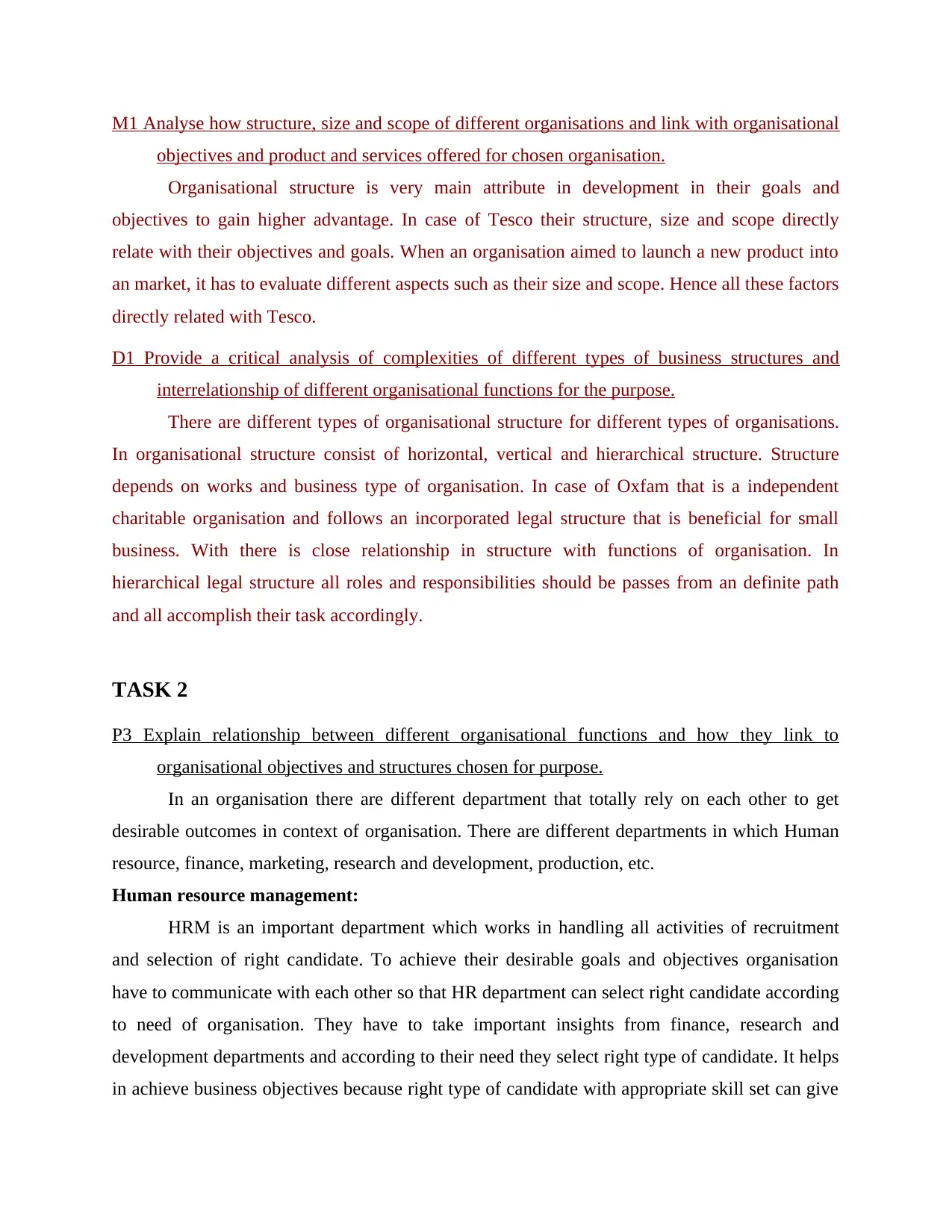
M1 Analyse how structure, size and scope of different organisations and link with organisational
objectives and product and services offered for chosen organisation.
Organisational structure is very main attribute in development in their goals and
objectives to gain higher advantage. In case of Tesco their structure, size and scope directly
relate with their objectives and goals. When an organisation aimed to launch a new product into
an market, it has to evaluate different aspects such as their size and scope. Hence all these factors
directly related with Tesco.
D1 Provide a critical analysis of complexities of different types of business structures and
interrelationship of different organisational functions for the purpose.
There are different types of organisational structure for different types of organisations.
In organisational structure consist of horizontal, vertical and hierarchical structure. Structure
depends on works and business type of organisation. In case of Oxfam that is a independent
charitable organisation and follows an incorporated legal structure that is beneficial for small
business. With there is close relationship in structure with functions of organisation. In
hierarchical legal structure all roles and responsibilities should be passes from an definite path
and all accomplish their task accordingly.
TASK 2
P3 Explain relationship between different organisational functions and how they link to
organisational objectives and structures chosen for purpose.
In an organisation there are different department that totally rely on each other to get
desirable outcomes in context of organisation. There are different departments in which Human
resource, finance, marketing, research and development, production, etc.
Human resource management:
HRM is an important department which works in handling all activities of recruitment
and selection of right candidate. To achieve their desirable goals and objectives organisation
have to communicate with each other so that HR department can select right candidate according
to need of organisation. They have to take important insights from finance, research and
development departments and according to their need they select right type of candidate. It helps
in achieve business objectives because right type of candidate with appropriate skill set can give
objectives and product and services offered for chosen organisation.
Organisational structure is very main attribute in development in their goals and
objectives to gain higher advantage. In case of Tesco their structure, size and scope directly
relate with their objectives and goals. When an organisation aimed to launch a new product into
an market, it has to evaluate different aspects such as their size and scope. Hence all these factors
directly related with Tesco.
D1 Provide a critical analysis of complexities of different types of business structures and
interrelationship of different organisational functions for the purpose.
There are different types of organisational structure for different types of organisations.
In organisational structure consist of horizontal, vertical and hierarchical structure. Structure
depends on works and business type of organisation. In case of Oxfam that is a independent
charitable organisation and follows an incorporated legal structure that is beneficial for small
business. With there is close relationship in structure with functions of organisation. In
hierarchical legal structure all roles and responsibilities should be passes from an definite path
and all accomplish their task accordingly.
TASK 2
P3 Explain relationship between different organisational functions and how they link to
organisational objectives and structures chosen for purpose.
In an organisation there are different department that totally rely on each other to get
desirable outcomes in context of organisation. There are different departments in which Human
resource, finance, marketing, research and development, production, etc.
Human resource management:
HRM is an important department which works in handling all activities of recruitment
and selection of right candidate. To achieve their desirable goals and objectives organisation
have to communicate with each other so that HR department can select right candidate according
to need of organisation. They have to take important insights from finance, research and
development departments and according to their need they select right type of candidate. It helps
in achieve business objectives because right type of candidate with appropriate skill set can give
⊘ This is a preview!⊘
Do you want full access?
Subscribe today to unlock all pages.

Trusted by 1+ million students worldwide
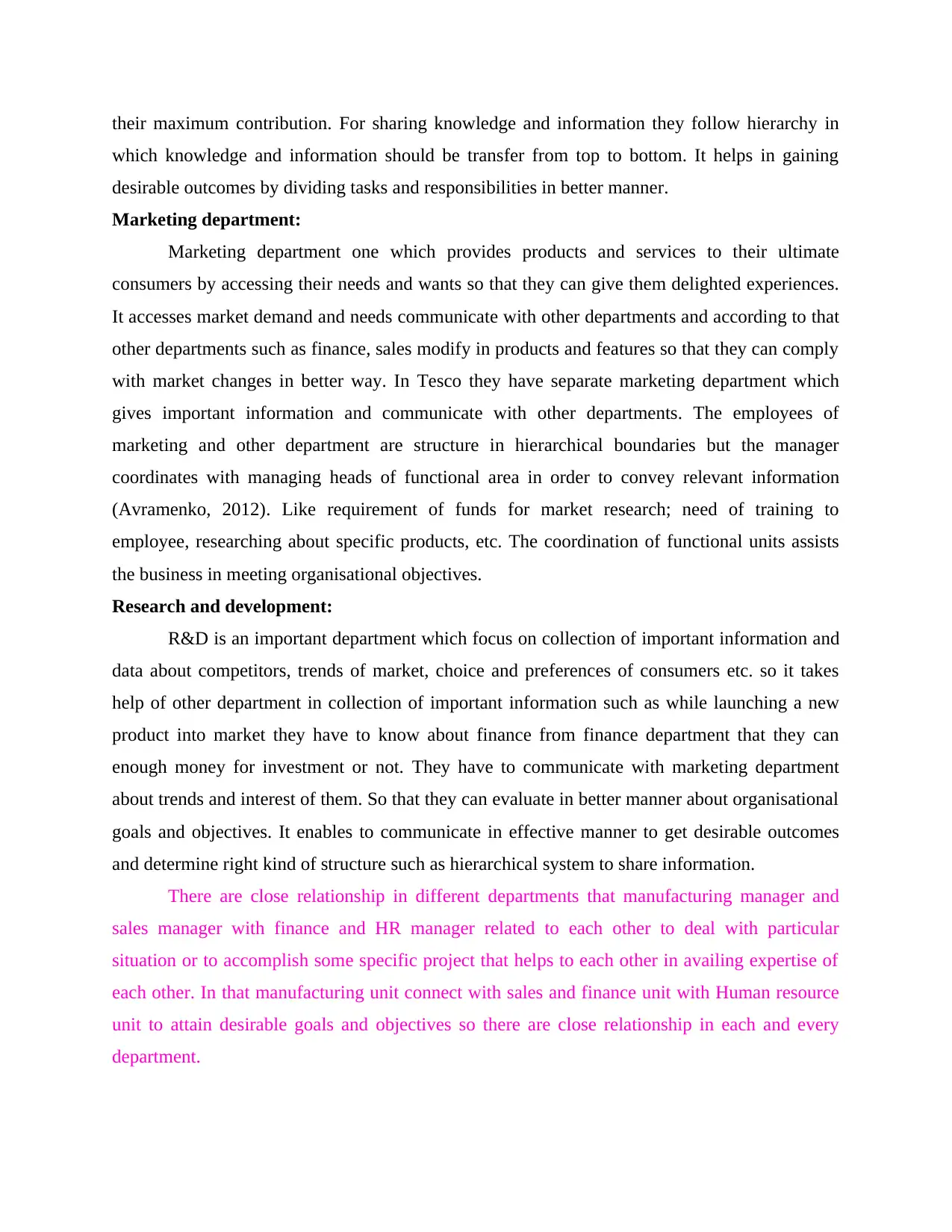
their maximum contribution. For sharing knowledge and information they follow hierarchy in
which knowledge and information should be transfer from top to bottom. It helps in gaining
desirable outcomes by dividing tasks and responsibilities in better manner.
Marketing department:
Marketing department one which provides products and services to their ultimate
consumers by accessing their needs and wants so that they can give them delighted experiences.
It accesses market demand and needs communicate with other departments and according to that
other departments such as finance, sales modify in products and features so that they can comply
with market changes in better way. In Tesco they have separate marketing department which
gives important information and communicate with other departments. The employees of
marketing and other department are structure in hierarchical boundaries but the manager
coordinates with managing heads of functional area in order to convey relevant information
(Avramenko, 2012). Like requirement of funds for market research; need of training to
employee, researching about specific products, etc. The coordination of functional units assists
the business in meeting organisational objectives.
Research and development:
R&D is an important department which focus on collection of important information and
data about competitors, trends of market, choice and preferences of consumers etc. so it takes
help of other department in collection of important information such as while launching a new
product into market they have to know about finance from finance department that they can
enough money for investment or not. They have to communicate with marketing department
about trends and interest of them. So that they can evaluate in better manner about organisational
goals and objectives. It enables to communicate in effective manner to get desirable outcomes
and determine right kind of structure such as hierarchical system to share information.
There are close relationship in different departments that manufacturing manager and
sales manager with finance and HR manager related to each other to deal with particular
situation or to accomplish some specific project that helps to each other in availing expertise of
each other. In that manufacturing unit connect with sales and finance unit with Human resource
unit to attain desirable goals and objectives so there are close relationship in each and every
department.
which knowledge and information should be transfer from top to bottom. It helps in gaining
desirable outcomes by dividing tasks and responsibilities in better manner.
Marketing department:
Marketing department one which provides products and services to their ultimate
consumers by accessing their needs and wants so that they can give them delighted experiences.
It accesses market demand and needs communicate with other departments and according to that
other departments such as finance, sales modify in products and features so that they can comply
with market changes in better way. In Tesco they have separate marketing department which
gives important information and communicate with other departments. The employees of
marketing and other department are structure in hierarchical boundaries but the manager
coordinates with managing heads of functional area in order to convey relevant information
(Avramenko, 2012). Like requirement of funds for market research; need of training to
employee, researching about specific products, etc. The coordination of functional units assists
the business in meeting organisational objectives.
Research and development:
R&D is an important department which focus on collection of important information and
data about competitors, trends of market, choice and preferences of consumers etc. so it takes
help of other department in collection of important information such as while launching a new
product into market they have to know about finance from finance department that they can
enough money for investment or not. They have to communicate with marketing department
about trends and interest of them. So that they can evaluate in better manner about organisational
goals and objectives. It enables to communicate in effective manner to get desirable outcomes
and determine right kind of structure such as hierarchical system to share information.
There are close relationship in different departments that manufacturing manager and
sales manager with finance and HR manager related to each other to deal with particular
situation or to accomplish some specific project that helps to each other in availing expertise of
each other. In that manufacturing unit connect with sales and finance unit with Human resource
unit to attain desirable goals and objectives so there are close relationship in each and every
department.
Paraphrase This Document
Need a fresh take? Get an instant paraphrase of this document with our AI Paraphraser
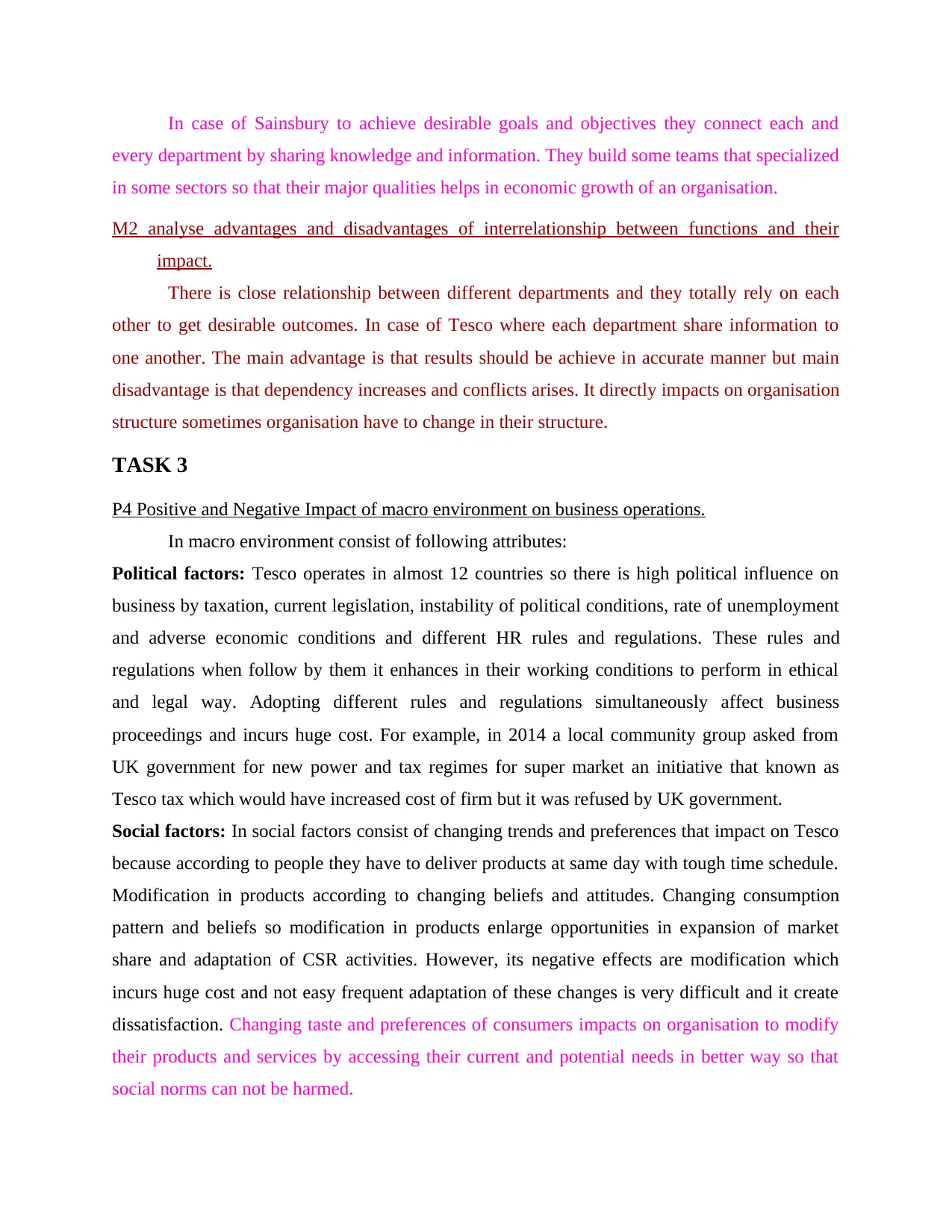
In case of Sainsbury to achieve desirable goals and objectives they connect each and
every department by sharing knowledge and information. They build some teams that specialized
in some sectors so that their major qualities helps in economic growth of an organisation.
M2 analyse advantages and disadvantages of interrelationship between functions and their
impact.
There is close relationship between different departments and they totally rely on each
other to get desirable outcomes. In case of Tesco where each department share information to
one another. The main advantage is that results should be achieve in accurate manner but main
disadvantage is that dependency increases and conflicts arises. It directly impacts on organisation
structure sometimes organisation have to change in their structure.
TASK 3
P4 Positive and Negative Impact of macro environment on business operations.
In macro environment consist of following attributes:
Political factors: Tesco operates in almost 12 countries so there is high political influence on
business by taxation, current legislation, instability of political conditions, rate of unemployment
and adverse economic conditions and different HR rules and regulations. These rules and
regulations when follow by them it enhances in their working conditions to perform in ethical
and legal way. Adopting different rules and regulations simultaneously affect business
proceedings and incurs huge cost. For example, in 2014 a local community group asked from
UK government for new power and tax regimes for super market an initiative that known as
Tesco tax which would have increased cost of firm but it was refused by UK government.
Social factors: In social factors consist of changing trends and preferences that impact on Tesco
because according to people they have to deliver products at same day with tough time schedule.
Modification in products according to changing beliefs and attitudes. Changing consumption
pattern and beliefs so modification in products enlarge opportunities in expansion of market
share and adaptation of CSR activities. However, its negative effects are modification which
incurs huge cost and not easy frequent adaptation of these changes is very difficult and it create
dissatisfaction. Changing taste and preferences of consumers impacts on organisation to modify
their products and services by accessing their current and potential needs in better way so that
social norms can not be harmed.
every department by sharing knowledge and information. They build some teams that specialized
in some sectors so that their major qualities helps in economic growth of an organisation.
M2 analyse advantages and disadvantages of interrelationship between functions and their
impact.
There is close relationship between different departments and they totally rely on each
other to get desirable outcomes. In case of Tesco where each department share information to
one another. The main advantage is that results should be achieve in accurate manner but main
disadvantage is that dependency increases and conflicts arises. It directly impacts on organisation
structure sometimes organisation have to change in their structure.
TASK 3
P4 Positive and Negative Impact of macro environment on business operations.
In macro environment consist of following attributes:
Political factors: Tesco operates in almost 12 countries so there is high political influence on
business by taxation, current legislation, instability of political conditions, rate of unemployment
and adverse economic conditions and different HR rules and regulations. These rules and
regulations when follow by them it enhances in their working conditions to perform in ethical
and legal way. Adopting different rules and regulations simultaneously affect business
proceedings and incurs huge cost. For example, in 2014 a local community group asked from
UK government for new power and tax regimes for super market an initiative that known as
Tesco tax which would have increased cost of firm but it was refused by UK government.
Social factors: In social factors consist of changing trends and preferences that impact on Tesco
because according to people they have to deliver products at same day with tough time schedule.
Modification in products according to changing beliefs and attitudes. Changing consumption
pattern and beliefs so modification in products enlarge opportunities in expansion of market
share and adaptation of CSR activities. However, its negative effects are modification which
incurs huge cost and not easy frequent adaptation of these changes is very difficult and it create
dissatisfaction. Changing taste and preferences of consumers impacts on organisation to modify
their products and services by accessing their current and potential needs in better way so that
social norms can not be harmed.
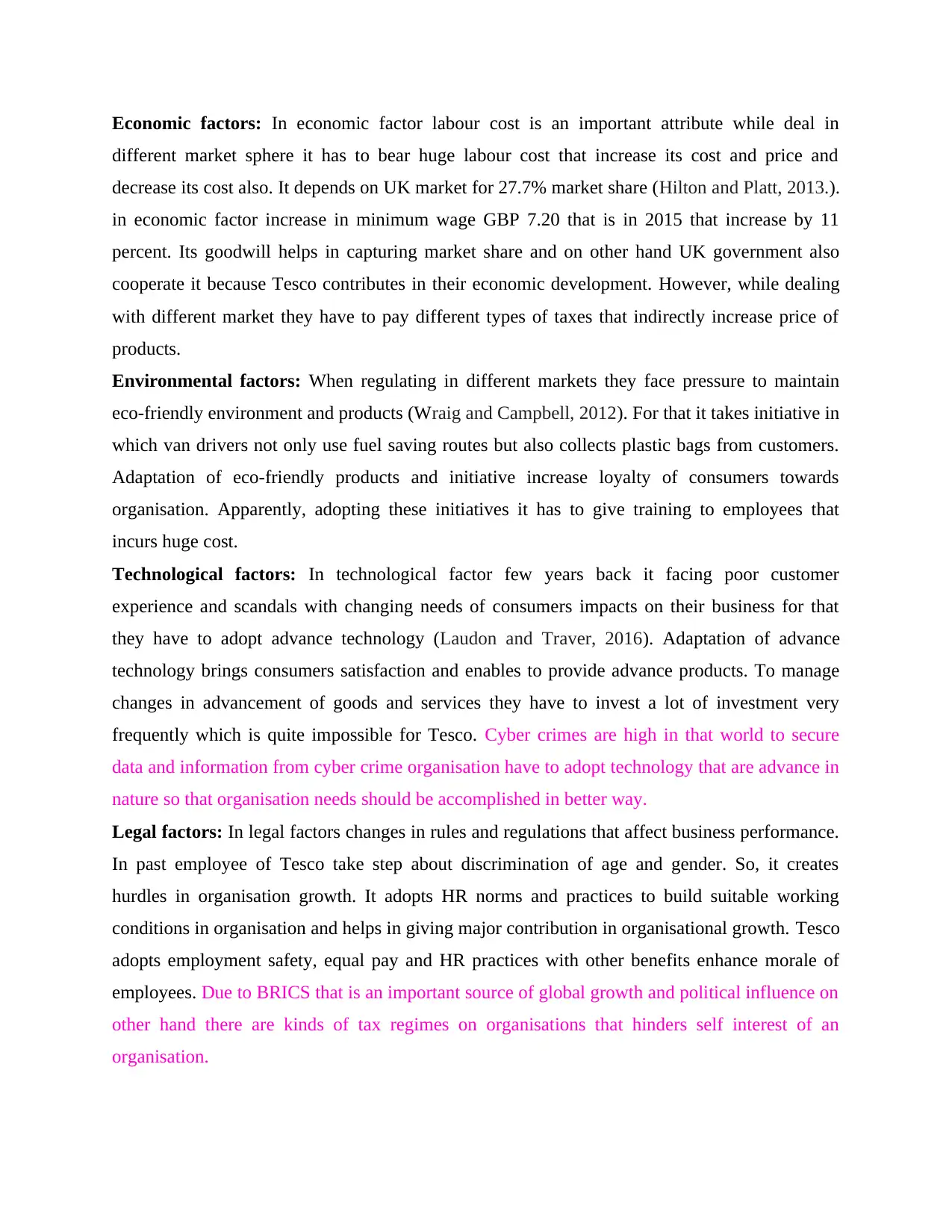
Economic factors: In economic factor labour cost is an important attribute while deal in
different market sphere it has to bear huge labour cost that increase its cost and price and
decrease its cost also. It depends on UK market for 27.7% market share (Hilton and Platt, 2013.).
in economic factor increase in minimum wage GBP 7.20 that is in 2015 that increase by 11
percent. Its goodwill helps in capturing market share and on other hand UK government also
cooperate it because Tesco contributes in their economic development. However, while dealing
with different market they have to pay different types of taxes that indirectly increase price of
products.
Environmental factors: When regulating in different markets they face pressure to maintain
eco-friendly environment and products (Wraig and Campbell, 2012). For that it takes initiative in
which van drivers not only use fuel saving routes but also collects plastic bags from customers.
Adaptation of eco-friendly products and initiative increase loyalty of consumers towards
organisation. Apparently, adopting these initiatives it has to give training to employees that
incurs huge cost.
Technological factors: In technological factor few years back it facing poor customer
experience and scandals with changing needs of consumers impacts on their business for that
they have to adopt advance technology (Laudon and Traver, 2016). Adaptation of advance
technology brings consumers satisfaction and enables to provide advance products. To manage
changes in advancement of goods and services they have to invest a lot of investment very
frequently which is quite impossible for Tesco. Cyber crimes are high in that world to secure
data and information from cyber crime organisation have to adopt technology that are advance in
nature so that organisation needs should be accomplished in better way.
Legal factors: In legal factors changes in rules and regulations that affect business performance.
In past employee of Tesco take step about discrimination of age and gender. So, it creates
hurdles in organisation growth. It adopts HR norms and practices to build suitable working
conditions in organisation and helps in giving major contribution in organisational growth. Tesco
adopts employment safety, equal pay and HR practices with other benefits enhance morale of
employees. Due to BRICS that is an important source of global growth and political influence on
other hand there are kinds of tax regimes on organisations that hinders self interest of an
organisation.
different market sphere it has to bear huge labour cost that increase its cost and price and
decrease its cost also. It depends on UK market for 27.7% market share (Hilton and Platt, 2013.).
in economic factor increase in minimum wage GBP 7.20 that is in 2015 that increase by 11
percent. Its goodwill helps in capturing market share and on other hand UK government also
cooperate it because Tesco contributes in their economic development. However, while dealing
with different market they have to pay different types of taxes that indirectly increase price of
products.
Environmental factors: When regulating in different markets they face pressure to maintain
eco-friendly environment and products (Wraig and Campbell, 2012). For that it takes initiative in
which van drivers not only use fuel saving routes but also collects plastic bags from customers.
Adaptation of eco-friendly products and initiative increase loyalty of consumers towards
organisation. Apparently, adopting these initiatives it has to give training to employees that
incurs huge cost.
Technological factors: In technological factor few years back it facing poor customer
experience and scandals with changing needs of consumers impacts on their business for that
they have to adopt advance technology (Laudon and Traver, 2016). Adaptation of advance
technology brings consumers satisfaction and enables to provide advance products. To manage
changes in advancement of goods and services they have to invest a lot of investment very
frequently which is quite impossible for Tesco. Cyber crimes are high in that world to secure
data and information from cyber crime organisation have to adopt technology that are advance in
nature so that organisation needs should be accomplished in better way.
Legal factors: In legal factors changes in rules and regulations that affect business performance.
In past employee of Tesco take step about discrimination of age and gender. So, it creates
hurdles in organisation growth. It adopts HR norms and practices to build suitable working
conditions in organisation and helps in giving major contribution in organisational growth. Tesco
adopts employment safety, equal pay and HR practices with other benefits enhance morale of
employees. Due to BRICS that is an important source of global growth and political influence on
other hand there are kinds of tax regimes on organisations that hinders self interest of an
organisation.
⊘ This is a preview!⊘
Do you want full access?
Subscribe today to unlock all pages.

Trusted by 1+ million students worldwide
1 out of 21
Related Documents
Your All-in-One AI-Powered Toolkit for Academic Success.
+13062052269
info@desklib.com
Available 24*7 on WhatsApp / Email
![[object Object]](/_next/static/media/star-bottom.7253800d.svg)
Unlock your academic potential
Copyright © 2020–2025 A2Z Services. All Rights Reserved. Developed and managed by ZUCOL.





